Universal Chalcidoidea Database
Notes on families
Agaonidae
N.B. Recent work using molecular sequences of the 28S rRNA gene indicate that the family as recognised here is probably polyphyletic (see Rasplus, et al. 1998). This work suggests that only the Agaoninae (ie fig pollinators) should be regarded as belonging to the Agaonidae (s.s.) whilst the Sycoecninae, Otitesellinae and Sycoryctinae should be included in the Pteromalidae. Placement of the Sycophaginae and Epichrysomallinae remains uncertain.
Main diagnostic characters
1. Fore wing with marginal vein at right angles to anterior wing margin or nearly so (80%)
2. Associated with figs (Ficus spp.) (100%)
3. Mid legs with femora and tibiae clearly much more slender than those of fore and hind legs (85%)
4. Females with a clearly exserted, sometimes immensely long ovipositor
(99%)
5. Males with wings very reduced or absent, and mandibles enlarged for fighting (95%)
Included taxa
The family currently includes 76 genera and 757 species placed in 6 subfamilies as follows: Agaoninae (20/358), Epichrysomallinae
(14/40), Otitesellinae (15/79), Sycoecinae (6/67), Sycophaginae
(7/59), Sycoryctinae (11/151), unplaced (3/3).
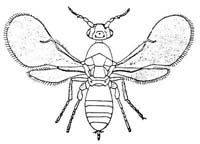 |
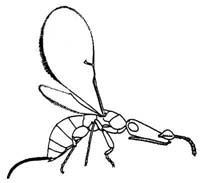 |
| Female | Female |
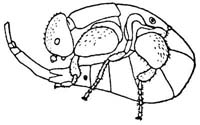 |
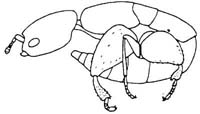 |
| Male | Male |
| Agaoninae (Blastophaga psenes) |
Agaoninae (Pleistodontes imperialis) |
Biology
Species of Agaonidae are always associated with figs; many act as pollinators of various Ficus spp. (Agaoninae), whereas others are probably parasitoids of the pollinators or gall-formers of other parts of the fig.
Figs and their associated species of agaonine pollinators are totally dependent on one another, since fig flowers can be pollinated only by the appropriate species of wasp, and no wasp can produce progeny outside the appropriate fig (Ramirez, 1970; Wiebes, 1982a). The relationship is therefore very close, both groups probably being descendents of a common ancestor-fig and its pollinator-wasp (Wiebes 1982a,b).
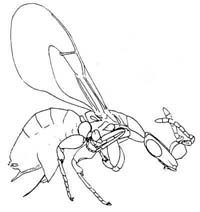 |
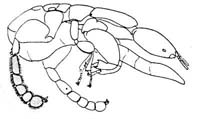 |
| Female | Male |
| Agaoninae (Blastophaga sp.) |
|
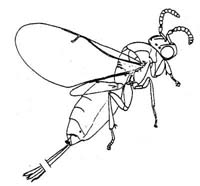 |
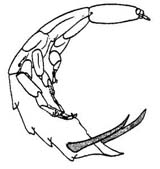 |
| Female | Male |
| Sycophaginae | |
Female agaonine fig-wasps normally enter the fig via the narrow ostiole, in the process losing their wings and often also parts of their antennae and legs (Wiebes 1982a, Valentine & Walker 1983). These females carry pollen from other figs, thus pollinating the flowers within the fig they enter and in which they will die. Pollen is tranported in pollen "pockets" on the thorax (Wiebes, 1976) in "corbicula" on each foreleg (Ramirez, 1969), folds of the intersegmental membrane of the gaster, on the anntennae and also in the digestive tract (see Boucek, 1988). The female wasps oviposit in the female fig flowers. The larvae of the pollinator wasp develop and pupate within the ovaries of these flowers. The wingless males emerge first and mate with the females whilst still inside the galled flowers. These males notmally bore a hole in the wall of the fig which allows the female wasp to emerge from the galled flowers. A few species of agaonines lay eggs without pollinating the fig flowers, and act as cuckoos (Wiebes, 1979).
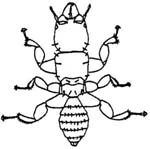 |
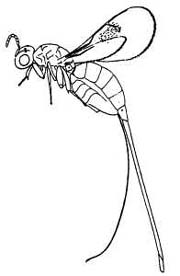 |
| Male | Female |
 |
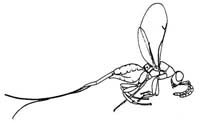 |
| Male | Female |
| Sycoryctinae | |
The immature stages have been described in detail only for Blastophaga psenes (Linnaeus) (Agaoninae) (Grandi, 1929; Buscalioni & Grandi, 1938). The deposited egg is oval with a long filament at one end. The first-instar larva is simple, translucent and thirteen-segmented. The mature larva is strongly curved, and the meso- and metathoracic segments each have a pair of slightly raised, rounded, ventrolateral protuberances.
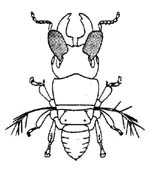 |
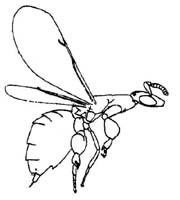 |
| Male | Female |
| Otitesellinae | |
Blastophaga psenes is probably the best known of all the fig-wasps since it is the sole pollinating agent of the edible fig, Ficus carica. This species of fig is gynandioecious, ie the female flowers occur only on one plant and the male and gall-flowers (non-reproductive) female flowers with a relatively short style) on another. Wasps that emerge from a fig, may fly to either a male or female plant. The well-known commercial edible seed-fig will be produced only if the wasps entering a female fig have emerged from a male fig, thus pollinating the flowers within the female fig. The use of Blastophaga psenes in producing figs commercially in North America has been summarised by Sisson (1970).
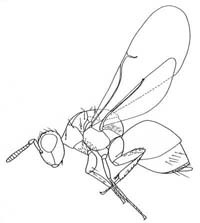
Female
Epichrysomallinae
(Herodotia subatrivetris)
At least some species of the subfamily Epichrysomallinae also gall the flowers of figs and in some instances may act as pollinators.
Species belonging to the subfamilies Sycoecinae, Sycophaginae and Otitesellinae may be gall formers in the non-reproductive parts of the fig or parasitoids of gall-formers.
Identification
Gordh, 1975 (revision of Idarnes); Boucek, 1993 (New World genera assocaited with Ficus fruit); Berg & Wiebes, 1992 (African Agaoninae); Wiebes, 1994 (Indo-Australian Agaoninae), 1995 (New World Agaoninae).
References
Berg, C.C.; Wiebes, J.T. 1992. African fig trees and fig wasps. Verhandelingen Koninklijke Nederlandse Akademie Wetenschappen 89:298pp.
Boucek, Z. 1988. Australasian Chalcidoidea (Hymenoptera). A biosystematic revision of genera of fourteen families, with a reclassification of species. :832pp.. CAB International, Wallingford, Oxon, U.K., Cambrian News Ltd; Aberystwyth, Wales.
Boucek, Z. 1993. The genera of chalcidoid wasps from Ficus fruit in the New World. Journal of Natural History 27:173-217.
Buscalioni, L.; Grandi, G. 1938. Il Ficus carica L., la sua biologia la sua coltivazione e i suoi rapporti con l'insetto pronubo (Blastophaga psenes L.). Boll. Ist. Ent. Univ. Bologna 10:223-280.
Gordh, G. 1975. The comparative external morphology and systematics of the Neotropical parasitic fig wasp Idarnes (Hymenoptera: Torymidae). University of Kansas Science Bulletin 50(9):389-455.
Grandi, G. 1929. Studio morfologico e biologico della Blastophaga psenes (L.). 2a ediz. riveduta. Boll. Lab. ent. Bologna 2:1-147.
Ramirez B., W. 1969. Fig wasps: the mechanism of pollen transfer. Science 163:580-581.
Ramirez B., W. 1970. Host specificity of fig-wasps (Hym., Agaonidae). Evolution 24:680-691.
Rasplus, J.-Y., Kerdelhuse, C., Clainche, I. le & Mondor, G. 1998. Molecular phylogeny of fig wasps. Agaonidae are not monophyletic. Comptes Rendus de l'Academie des Sciences (III) 321(6):517-527
Sisson, R.F. 1970. The wasp that plays cupid to a fig. National Geographic 138(5):690-697, 12 pls.
Valentine, E.W.; Walker, A.K. 1983. Three families of Hymenoptera new to New Zealand. New Zealand Entomologist 7:397-400.
Wiebes, J.T. 1976. A short history of fig wasp research. Gard. Bulletin, Singapore 29:207-232.
Wiebes, J.T. 1979. Co-evolution of figs and their insect pollinators. Ann. Rev. Ecol. & Syst. 10:1-12.
Wiebes, J.T. 1982a. Biogeography and ecology of New Guinea, Nos 1 and 2. Chapter 14. Fig wasps (Hymenoptera). Monographie Biologicae 42:735-755. (Ed.: Gressitt, J.L.) Dr W. Junk Publishers, The Hague, Netherlands (ISBN 90-6193-094-4)
Wiebes, J.T. 1982b. The phylogeny of the Agaonidae (Hymenoptera, Chalcidoidea). Netherlands Journal of Zoology 32(3):395-411.
Wiebes, J.T. 1994. The Indo-Australian Agaoninae (pollinators of figs). Verhandelingen Koninklijke Nederlandse Akademie Wetenschappen 92:208pp.
Wiebes, J.T. 1995. The New World Agaoninae (pollinators of figs).
Verhandelingen Koninklijke Nederlandse Akademie Wetenschappen
94:60pp.
Last updated 07-Jun-2004 Dr B R Pitkin